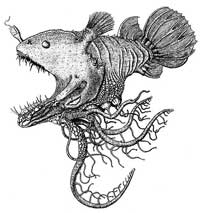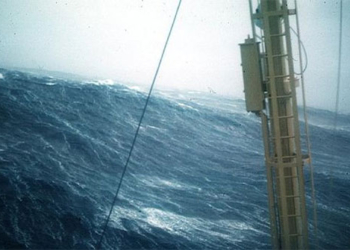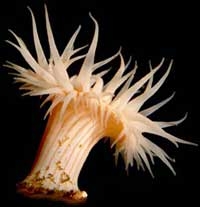 It is quite rare to encounter the deep-sea anglerfish (Scientific name: Linophryne brevibarbata), but occasionally, trawlers manage to “catch” a few. Typically, they capture a pair of these “couples” at once. There are many intriguing aspects of this fish species.
It is quite rare to encounter the deep-sea anglerfish (Scientific name: Linophryne brevibarbata), but occasionally, trawlers manage to “catch” a few. Typically, they capture a pair of these “couples” at once. There are many intriguing aspects of this fish species.
The anglerfish lives in an environment completely devoid of day and night. It is always surrounded by an inky black darkness.
Compared to its body size, the female has a remarkably large mouth that can easily swallow a fish nearly as big as itself when opened wide. Consequently, when it consumes a “large-sized” prey, its stomach expands significantly.
Since food is scarce on the deep-sea floor, females are naturally equipped with a bioluminescent organ to increase their chances of catching prey. The “glowing fish” wiggles its “luminous lure” right in front of its mouth to entice unsuspecting prey. When the timing is just right, it simply opens its mouth wide and swallows the entire prey.
The female’s mouth and teeth appear quite fearsome: sharp, pointed teeth protrude from its upper jaw even when its mouth is closed. Its eyes often seem to be staring intently forward. The body of the female is round, looking rather peculiar. The “luminous lure” only functions in the pitch-black environment.
 In the dark depths of the ocean, the male (which is tiny and has sensory organs on its head) swims in search of a female. The male’s mouth lacks teeth but has protruding parts used to… attach itself to the female. Upon contact, the male fuses its tissues with the female’s bloodstream, relying on the nutrients provided by her body. From that point on, the male remains attached to the female for life, demonstrating a peculiar form of parasitic loyalty.
In the dark depths of the ocean, the male (which is tiny and has sensory organs on its head) swims in search of a female. The male’s mouth lacks teeth but has protruding parts used to… attach itself to the female. Upon contact, the male fuses its tissues with the female’s bloodstream, relying on the nutrients provided by her body. From that point on, the male remains attached to the female for life, demonstrating a peculiar form of parasitic loyalty.
The eggs are laid in the water, forming a gelatinous mass that is fertilized by the attaching male. This gelatinous mass floats to the surface, living as plankton for a time before… bidding farewell to the sun and returning to the dark ocean floor.
The male can grow to about 2 cm in length, while the female can reach around 10 cm.





















































